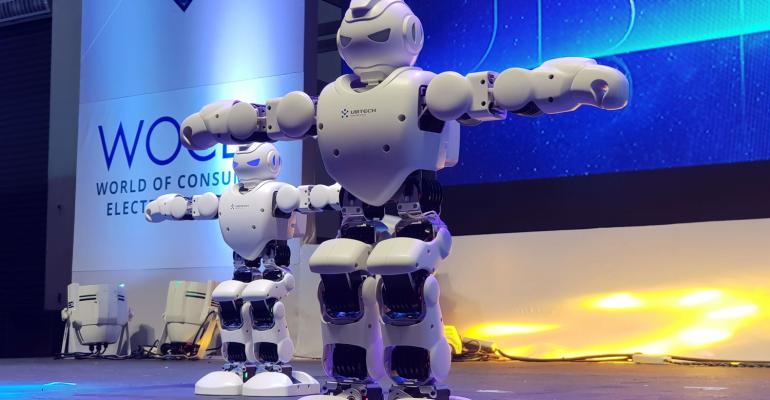The country’s industrial initiative, Made in China 2025, is positioning it to become an industrial leader—especially in the field of robotics.
In December 2016, Mark Cuban—owner of the Dallas Mavericks, serial entrepreneur, and co-host of “Shark Tank”—penned a letter to President Donald Trump, urging him to invest $100 billion into the U.S. robotics industry. Why? Because China is poised to take the lead in the robotic industry race.
China, a Global Robotic Leader According to the International Federation of Robots, China will lay claim to 40% of total worldwide robotic sales by 2019, an increase from 27% percent in 2015. China is currently the biggest shareholder of the robotic global market at a net worth of $30 billion. It is currently ranked No. 1 in sales for industrial robots. South Korea and Japan are ranked second and third, respectively. The U.S. is ranked fourth.

The major reason for China’s increase in the robotic market is its industry initiative plan, Made in China 2025. Back in 2015, its government devised a massive tech plan to become the leader in several industry sectors, including medical, aerospace, energy, and robotics. Along with this initiative, China developed the Robotics Industry Development Plan. This is a five-year plan to rapidly expand its industrial robotic sector. China wants to be able to manufacture at least 100,000 industrial robots per year by 2020. The Chinese government wants that majority of robotic orders in China to be fulfilled by Chinese robotic companies instead of foreign companies. Currently, China purchases most of its robotic force. Between 2010 and 2015, it installed 90,000 industrial robots, representing one-third of the world’s total. The rest of Asia, along with Europe and the U.S., installed 80,000 industrial robots combined.
Robots are not China’s only target. The country is also investing heavily into accompanying technology like machine learning and artificial intelligence. All of this is to construct a highly developed automated workforce. Today, China’s middle- and lower-class workforce is on the social rise. The salaries for the current workforce have increased by more than 100% in the last 10 years. At the same time, the rise of these classes and the old age of some its employees have caused a decline in the labor force for China. Several companies are looking towards automation to maintain their production rates in the face of changes in the labor force. Foxconn, a leading supplier of Apple iPhones, replaced 60,000 laborers with robots last year alone.
Future Robotic Investments and Development
“China can manufacture simple robots, but nothing complicated like the six-axis ones by Japan, Germany, and the U.S.,” said Zi Yang, a China analyst from the Jamestown Foundation in Washington, D.C. “It’s hard to close the gap due to several reasons—mainly because of China’s lack of innovativeness due to its weak intellectual property laws, and government-led projects that focus on quantity over quality.”
To help close that gap and meet the mandate of 400,000 by the end of 2020, Chinese tech companies have invested and acquired in robotic leaders. Last year, Midea, an electrical appliance manufacturer, purchased German robotics company Kuka. The latter firm’s CEO, Till Reuter, told CNBC that it wants to be the number one robotics company in China, which is its largest market with an estimated growth rate of 20 to 25%.
Alibaba is China’s answer to Amazon and the largest online retailer in the world. Recently, the artificial intelligence (AI) software developed by its Institute of Data Science of Technologies outperformed humans on reading comprehension. The software scored a 82.44, while the humans scored 82.304. AI is part of the tech drive for China and would most certainly be integrated into its advanced robotic programs.
Unitree Robotics is another Chinese robotic company that looks to be competition for Boston Dynamics. Boston Dynamics is famously known for its quadruped, animal-like robots like Spot and Alpha Dog. Unitree founder and roboticist Xing Wang has long admired Marc Raibert, founder and president of Boston Dynamics. Unitree’s first robot is Laikago, a four-legged robodog that has the ability to remain stable on uneven surfaces, even when it is pushed or kicked. Unitree created everything from scratch, including the mechanical structure, control system, and motion control algorithms. The robot still lacks sensors or cameras and is not autonomous like some of the robots from Boston Dynamics. However, with a new angel investor, Wang is looking to make his robots as common and affordable as smartphones are today.
Jeff Burnstein, president of the Association for Advancing Automation, has been impressed with China’s robotic growth over the last five years and agrees that its appears to be in the best position to take lead of the robotic industry. “The Chinese are the fastest-growing and largest user of robotics in the world by now,” he said. “The 2025 plan will only accelerate it.”



